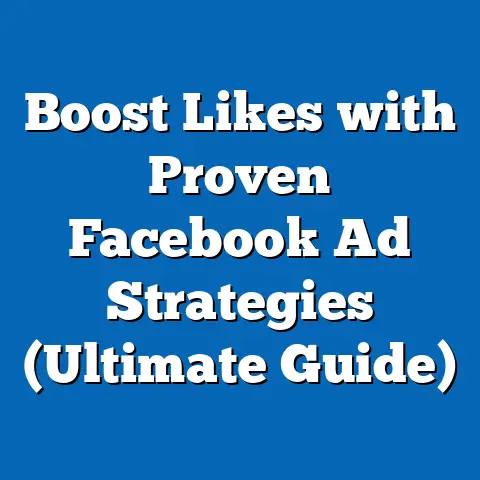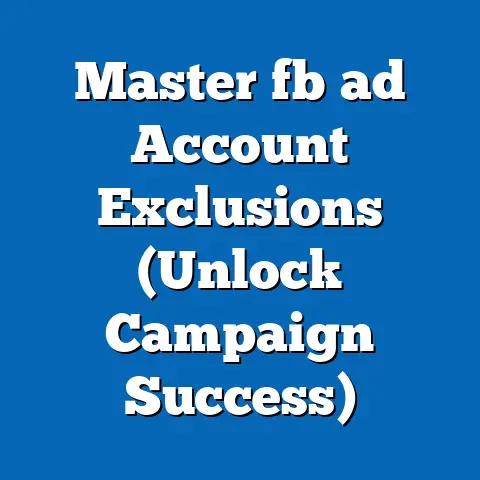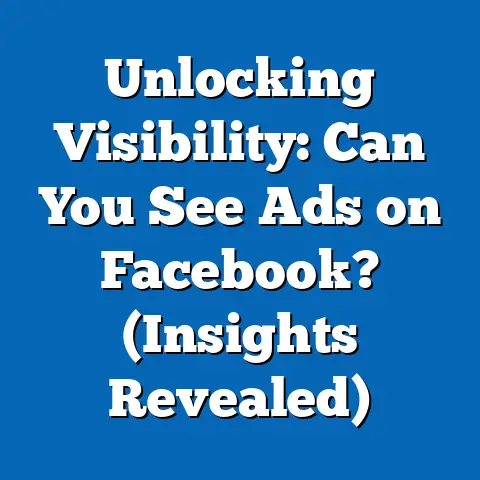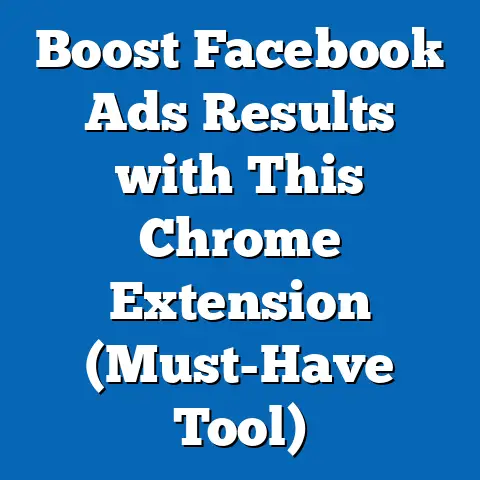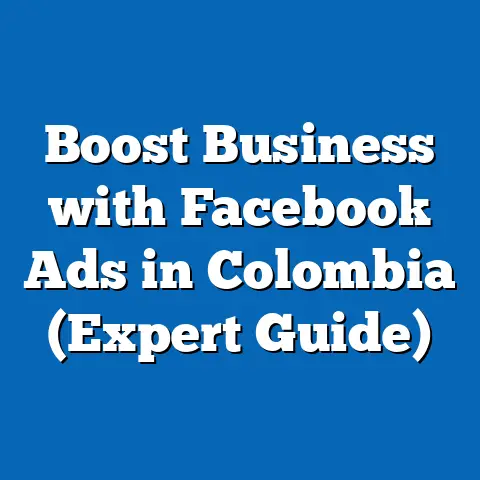Transform Facebook Video Ads (Expert Strategies Revealed)
In today’s digital world, if you’re not using video, you’re missing out. I’ve seen firsthand how powerful video can be in capturing attention and driving results, especially on platforms like Facebook. Video ads are not just a trend; they are arguably the best option for businesses aiming to enhance their online presence, truly engage their audience, and skyrocket conversions. The explosive growth of video content on social media is undeniable, and Facebook has emerged as a leader in this space. This makes video ads a crucial component of any effective modern marketing strategy.
Consider this: according to a recent HubSpot study, video marketers get 66% more qualified leads per year. And Wyzowl reports that 87% of marketers say video has increased traffic to their website. These numbers don’t lie.
In this guide, I’m going to share expert strategies that will unlock the full potential of Facebook video ads. My goal is to help you transform your ad campaigns for maximum impact. I’ll walk you through everything from understanding the power of video to crafting compelling ads, targeting the right audience, optimizing placements, and measuring success. Let’s dive in!
Understanding the Power of Video Content on Facebook
The social media marketing landscape is constantly evolving, but one thing remains constant: the dominance of visual content. And within visuals, video reigns supreme.
The Reign of Video
Think about your own behavior on Facebook. What catches your eye as you scroll through your feed? Is it a wall of text, or a captivating video? For most of us, it’s the latter. Users engage with video content far more readily than with other formats like images or text.
Here’s why:
- Attention-grabbing: Videos are dynamic and immediately capture attention.
- Information-rich: You can convey a lot of information in a short video.
- Emotionally engaging: Videos can evoke emotions and create connections with your audience.
Studies consistently show the effectiveness of video ads in driving engagement and conversions. For instance, a Facebook study found that users spend 5x longer watching video than static content. This increased engagement translates into higher brand recall and a greater likelihood of conversions.
Storytelling: The Heart of Video
One of the most powerful aspects of video is its ability to tell a story. Storytelling isn’t just about recounting events; it’s about creating an emotional connection with your audience. A well-crafted story can captivate viewers, make them feel something, and ultimately, influence their behavior.
I remember working with a local bakery that wanted to promote their new line of artisanal breads. Instead of simply showing pictures of the bread, we created a short video that told the story of the baker, his passion for his craft, and the history behind the recipes. The video resonated deeply with the audience, leading to a significant increase in sales and a surge in positive reviews.
Key Takeaway: Video is the king of content on Facebook. Use its power to tell stories and connect with your audience on an emotional level.
Crafting Compelling Video Ads
Creating a successful Facebook video ad isn’t just about slapping together some footage and hoping for the best. It requires careful planning and attention to detail. There are key elements that you need to nail to make your video truly compelling.
The Four Pillars of a Successful Video Ad
- Hook: The first few seconds are critical. You need to grab the viewer’s attention immediately.
- Storytelling: Create an engaging narrative that resonates with your target audience.
- Visuals: Use high-quality visuals and audio to keep viewers engaged.
- Call-to-Action (CTA): Tell viewers what you want them to do next.
Hook, Line, and Sinker
Your hook is your first impression. It’s what determines whether someone will keep watching or scroll past your ad. Here are some ideas for creating a strong hook:
- Ask a question: “Are you tired of struggling with [problem]?”
- Make a bold statement: “This one trick will change your life.”
- Show something visually stunning: Start with a captivating image or scene.
I’ve found that using a combination of visual and audio elements can be particularly effective. For example, a short, attention-grabbing animation with a voiceover that poses a question can be a great way to start your video.
Weaving a Narrative
Once you’ve hooked your viewers, you need to keep them engaged with a compelling story. This doesn’t mean you need to create a Hollywood-style production. It simply means crafting a narrative that resonates with your target audience and connects with their emotions.
Think about what your audience cares about. What are their pain points? What are their aspirations? Use your video to address these issues and show how your product or service can help them achieve their goals.
The Importance of Visuals and Audio
High-quality visuals and audio are essential for keeping viewers engaged. No one wants to watch a blurry, poorly lit video with muffled sound. Make sure your video is well-produced and visually appealing.
Here are some technical aspects to keep in mind:
- Resolution: Aim for at least 1080p resolution for crisp, clear visuals.
- Sound quality: Use a good microphone to ensure clear, professional-sounding audio.
- Lighting: Proper lighting is crucial for creating visually appealing videos.
I’ve learned the hard way that investing in good equipment pays off. A professional-looking video will always outperform a poorly produced one, even if the content is similar.
Key Takeaway: Craft your video ads with a strong hook, engaging storytelling, high-quality visuals, and a clear call-to-action.
Targeting the Right Audience
You can have the most amazing video ad in the world, but if you’re showing it to the wrong people, it’s not going to be effective. That’s why audience targeting is so crucial.
The Power of Precision
Facebook offers a wealth of targeting options that allow you to reach specific groups of people based on their demographics, interests, and behaviors. This level of precision is what makes Facebook advertising so powerful.
Here are some of the targeting options available:
- Demographics: Target people based on age, gender, education, and location.
- Interests: Target people based on their interests, hobbies, and the pages they like.
- Behaviors: Target people based on their online behavior, such as their purchase history and the types of ads they click on.
Creating Buyer Personas
To make the most of Facebook’s targeting options, it’s helpful to create buyer personas. A buyer persona is a fictional representation of your ideal customer. It’s based on research and data about your existing customers, as well as educated guesses about your target audience.
When creating buyer personas, consider the following:
- Demographics: What is their age, gender, location, and income?
- Interests: What are their hobbies, interests, and favorite brands?
- Pain points: What are their biggest challenges and frustrations?
- Goals: What are they trying to achieve?
By understanding your target audience on a deep level, you can create video ads that resonate with them and address their specific needs and desires.
Custom and Lookalike Audiences
Facebook also offers two powerful targeting options called Custom Audiences and Lookalike Audiences.
- Custom Audiences: These allow you to target people who have already interacted with your business, such as website visitors, email subscribers, and customers.
- Lookalike Audiences: These allow you to target people who are similar to your existing customers. Facebook uses its data to identify users who share similar characteristics and behaviors with your Custom Audiences.
I’ve found that Lookalike Audiences can be particularly effective for expanding your reach and finding new customers who are likely to be interested in your products or services.
Key Takeaway: Targeting the right audience is essential for the success of your Facebook video ads. Use Facebook’s targeting options, create buyer personas, and leverage Custom and Lookalike Audiences to reach your ideal customers.
Maximizing Ad Placement and Format
Where your video ad appears on Facebook and how it’s formatted can significantly impact its performance. Facebook offers a variety of ad placements and formats, each with its own advantages and disadvantages.
Choosing the Right Placement
Here are some of the ad placements available on Facebook:
- News Feed: This is the main feed that users see when they log into Facebook.
- Stories: These are short, vertical videos that disappear after 24 hours.
- In-stream video ads: These are ads that play before, during, or after other videos.
The best placement for your video ad will depend on your campaign goals and audience behavior. For example, if you’re trying to reach a broad audience and drive brand awareness, the News Feed might be the best option. If you’re targeting a younger audience and want to create a sense of urgency, Stories might be more effective.
Format Matters
Facebook also offers a variety of video ad formats, including:
- Square videos: These are ideal for the News Feed and can be easily viewed on mobile devices.
- Vertical videos: These are perfect for Stories and offer an immersive viewing experience.
- Landscape videos: These are best suited for in-stream video ads and offer a cinematic viewing experience.
When choosing a format, consider the placement where your ad will appear and the device that your audience is likely to be using.
Automatic Placements: The Easy Button
If you’re not sure which placements to choose, Facebook offers an Automatic Placements feature. This allows Facebook to automatically optimize your ad placement based on its data and algorithms.
I’ve found that Automatic Placements can be a great way to get started, especially if you’re new to Facebook advertising. However, it’s important to monitor your ad performance and make adjustments as needed.
Video Length: Short vs. Long
The optimal video length will depend on the placement and the message you’re trying to convey. In general, shorter videos tend to perform better than longer videos, especially in the News Feed and Stories.
However, longer videos can be effective for in-stream video ads and for conveying more complex information. Just make sure that you keep your audience engaged throughout the entire video.
Key Takeaway: Experiment with different ad placements and formats to find what works best for your campaign goals and audience behavior. Don’t be afraid to use Automatic Placements, but always monitor your ad performance and make adjustments as needed.
Analyzing and Measuring Success
Running Facebook video ads is only half the battle. To truly transform your campaigns, you need to analyze your results and measure your success.
Key Performance Indicators (KPIs)
Here are some of the key performance indicators (KPIs) that you should track when running Facebook video ads:
- View count: The number of times your video has been viewed.
- Engagement rate: The percentage of viewers who have interacted with your video (e.g., liked, commented, shared).
- Conversion rate: The percentage of viewers who have taken a desired action (e.g., made a purchase, signed up for a newsletter).
- Cost per view (CPV): The average cost of each video view.
- Return on ad spend (ROAS): The amount of revenue generated for every dollar spent on advertising.
Facebook Ads Manager: Your Data Hub
Facebook Ads Manager is your go-to tool for analyzing your ad performance. It provides a wealth of data and insights that can help you understand what’s working and what’s not.
Use Ads Manager to track your KPIs, identify trends, and make data-driven decisions about your ad campaigns.
A/B Testing: The Secret Weapon
A/B testing is a powerful technique for optimizing your video ads. It involves creating two versions of your ad (A and B) and showing them to different segments of your audience. By comparing the performance of the two versions, you can identify which one is more effective.
A/B testing can be used to test different video creatives, targeting strategies, and ad placements.
Iteration: The Path to Improvement
The key to transforming your Facebook video ads is to continuously iterate and improve based on your performance data. Don’t be afraid to experiment with new ideas and strategies. And always be learning and adapting to the changing landscape of Facebook advertising.
Key Takeaway: Analyze your results, measure your success, and continuously iterate and improve your video ad campaigns based on performance data.
Real-Life Case Studies and Success Stories
To illustrate the power of these expert strategies, let’s take a look at some real-life case studies and success stories.
Case Study 1: Local Restaurant
A local restaurant wanted to promote its new menu items and attract more customers. They created a series of short video ads showcasing the dishes and highlighting the restaurant’s unique atmosphere.
The results were impressive:
- Increased website traffic by 40%.
- Increased online orders by 25%.
- Generated a buzz on social media, with customers sharing the videos and tagging their friends.
Case Study 2: E-commerce Business
An e-commerce business wanted to increase sales of its new product line. They created a series of video ads that demonstrated the product’s features and benefits.
The results were even more dramatic:
Another expert, Amy Porterfield, emphasizes the importance of storytelling in video ads. “People don’t buy products or services,” she says. “They buy stories. Use your video ads to tell a compelling story that resonates with your audience and connects with their emotions.”
Key Takeaway: These case studies and expert insights demonstrate the power of Facebook video ads when used strategically. Learn from these examples and apply the expert strategies discussed in this article to transform your own ad campaigns.
Embracing the Future of Facebook Video Advertising
As we’ve seen, Facebook video ads offer a powerful way to connect with your audience, drive engagement, and boost conversions. By understanding the power of video content, crafting compelling ads, targeting the right audience, maximizing ad placement and format, and analyzing your results, you can transform your Facebook video ads and achieve your marketing goals.
Don’t be afraid to experiment, try new things, and continuously iterate and improve based on your performance data. The world of Facebook advertising is constantly evolving, so it’s important to stay up-to-date on the latest trends and best practices.
Embrace the future of Facebook video advertising and unlock the full potential of this powerful marketing channel. By doing so, you’ll not only reach but also engage and convert audiences in an increasingly competitive digital landscape. Now, go out there and create some amazing video ads!

